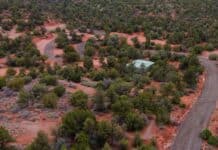Another year adds another study to the Sedona City Council’s agenda.
Council is already planning the first project for the new sustainability team manager. And it’s looking at off-highway vehicles’ environmental impacts.
OHVs have been driving through Sedona streets and surrounding National Forest trails for years. Continually the discussion has revolved around how to mitigate the noise, pollution and congestion caused by Jeeps, ATVs and other off-roading vehicles.
“What the state law allows us is very limited because of the fact that they are street legal and we cannot prohibit them or limit the numbers of them in a day like a lot of residents want,” City Attorney Kurt Christianson said. “So in order to do more than that, we need to show that there’s a tie to a public safety detriment. And we don’t have that data yet.”
In 2017, the city put together a comprehensive report of the impacts of OHVs. This breakdown showed how often OHVs were being used at trailheads all over the city.
Specifically, between July and November of 2017, the study found that Broken Arrow Trail averaged 44 OHV touring trips and 37 4×4 vehicle trips a day on their busiest days of the week, Friday through Sunday.
The number of touring and vehicle trips more than likely exceeds 4,860 trips on the weekends in the five months the report is based on. However, that report was conducted more than four years ago with no updates since.
Council also discussed the possibility of going to the Arizona State Legislature with their own lobbyist to advocate for statewide regulations. Ultimately, the discussion turned to rely on partnerships with the county and the U.S. Forest Service to push for change in regulation.
“I have been told by the County Supervisors Association [of Arizona] that they’re actually trying to work with our state legislatures to regulate the OHVs, statewide,” Vice Mayor Scott Jablow said. “But if taking care of our city would help our neighbors … this issue can be minimized or go away.”
Council discussed the sustainability impacts on the city currently, such as OHV and traffic emissions.
Based on city reports, USFS will be formally responding to the city for OHV reservations or limits in the forest by the end of January. But District Ranger Amy Tinderholt from the Red Rock Ranger District of the Coconino National Forest has already said that the Forest Service is not open to limiting the amount of OHV in the forest or at trailheads.
According to these reports, USFS also would approach other mitigation proposals before those limitations.
OHV rental companies in the Sedona area that were contacted about their vehicles’ environmental impacts declined to comment on the potential regulations.
The sustainability team has been in full operation since 2020. After the Climate Action Plan was approved by City Council in the summer of 2021, the team was made responsible for all the goals laid out by the city.
Currently, the city’s sustainability team has been operating without a manager for four months. As the new manager Alicia Peck begins her position in late January, the city hopes this will put the Climate Action Plan initiatives forward.
“I was encouraged that the council is open to the possibility of increasing support for the Sustainability Department, which has a very aggressive list of projects on its plate. We’re looking forward to the arrival of our new Sustainability Manager to help define what is possible to accomplish,” Councilman Jon Thompson said.
Since Thompson’s addition to the council, he has been one of the main leaders towards sustainability, stating many times that climate change is the most important long-term issue in the city.
Other projects are in motion for the city’s environment and sustainability initiatives. The city has agreed to contracts for tree care in the city for $102,000 annually, increased wastewater funding within the upcoming fiscal years and a push towards available electric car charging stations around Sedona.



















